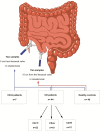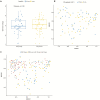Bacterial Mucosa-associated Microbiome in Inflamed and Proximal Noninflamed Ileum of Patients With Crohn's Disease
- PMID: 32448900
- PMCID: PMC7737161
- DOI: 10.1093/ibd/izaa107
Bacterial Mucosa-associated Microbiome in Inflamed and Proximal Noninflamed Ileum of Patients With Crohn's Disease
Abstract
Background: Microbiota is most likely essential in the pathogenesis of Crohn's disease (CD). Fecal diversion after ileocecal resection (ICR) protects against CD recurrence, whereas infusion of fecal content triggers inflammation. After ICR, the majority of patients experience endoscopic recurrence in the neoterminal ileum, and the ileal microbiome is of particular interest. We have assessed the mucosa-associated microbiome in the inflamed and noninflamed ileum in patients with CD.
Methods: Mucosa-associated microbiome was assessed by 16S rRNA sequencing of biopsies sampled 5 and 15 cm orally of the ileocecal valve or ileocolic anastomosis.
Results: Fifty-one CD patients and forty healthy controls (HCs) were included in the study. Twenty CD patients had terminal ileitis, with endoscopic inflammation at 5 cm, normal mucosa at 15 cm, and no history of upper CD involvement. Crohn's disease patients (n = 51) had lower alpha diversity and separated clearly from HC on beta diversity plots. Twenty-three bacterial taxa were differentially represented in CD patients vs HC; among these, Tyzzerella 4 was profoundly overrepresented in CD. The microbiome in the inflamed and proximal noninflamed ileal mucosa did not differ according to alpha diversity or beta diversity. Additionally, no bacterial taxa were differentially represented.
Conclusions: The microbiome is similar in the inflamed and proximal noninflamed ileal mucosa within the same patients. Our results support the concept of CD-specific microbiota alterations and demonstrate that neither ileal sublocation nor endoscopic inflammation influence the mucosa-associated microbiome.
Keywords: Crohn’s disease; microbiome; mucosal microbiota.
© 2020 Crohn’s & Colitis Foundation. Published by Oxford University Press on behalf of Crohn’s & Colitis Foundation.
Figures






Comment in
-
Reply to "Too Soon to Dismiss Inflammation-Related Differences in the Mucosa-Associated Microbiota in Crohn's Disease Patients".Inflamm Bowel Dis. 2022 Aug 1;28(8):e121. doi: 10.1093/ibd/izac047. Inflamm Bowel Dis. 2022. PMID: 35460413 Free PMC article. No abstract available.
-
Letter to the Editor: Too Soon to Dismiss Inflammation-Related Differences in the Mucosa-Associated Microbiota in Crohn's Disease Patients.Inflamm Bowel Dis. 2022 Aug 1;28(8):e120. doi: 10.1093/ibd/izac041. Inflamm Bowel Dis. 2022. PMID: 35460422 No abstract available.
Similar articles
-
IL23R-Protective Coding Variant Promotes Beneficial Bacteria and Diversity in the Ileal Microbiome in Healthy Individuals Without Inflammatory Bowel Disease.J Crohns Colitis. 2019 Mar 30;13(4):451-461. doi: 10.1093/ecco-jcc/jjy188. J Crohns Colitis. 2019. PMID: 30445599
-
After Surgically Induced Remission, Ileal and Colonic Mucosa-Associated Microbiota Predicts Crohn's Disease Recurrence.Clin Gastroenterol Hepatol. 2025 Mar;23(4):612-620.e10. doi: 10.1016/j.cgh.2024.06.022. Epub 2024 Jul 4. Clin Gastroenterol Hepatol. 2025. PMID: 38969076
-
Crohn's Disease Differentially Affects Region-Specific Composition and Aerotolerance Profiles of Mucosally Adherent Bacteria.Inflamm Bowel Dis. 2020 Nov 19;26(12):1843-1855. doi: 10.1093/ibd/izaa103. Inflamm Bowel Dis. 2020. PMID: 32469069 Free PMC article.
-
The Interplay between Defensins and Microbiota in Crohn's Disease.Mediators Inflamm. 2017;2017:8392523. doi: 10.1155/2017/8392523. Epub 2017 Jan 26. Mediators Inflamm. 2017. PMID: 28246439 Free PMC article. Review.
-
Gut microbiota in Crohn's disease pathogenesis.World J Gastroenterol. 2025 Feb 14;31(6):101266. doi: 10.3748/wjg.v31.i6.101266. World J Gastroenterol. 2025. PMID: 39958442 Free PMC article. Review.
Cited by
-
Systematic Review: The Gut Microbiome and Its Potential Clinical Application in Inflammatory Bowel Disease.Microorganisms. 2021 Apr 30;9(5):977. doi: 10.3390/microorganisms9050977. Microorganisms. 2021. PMID: 33946482 Free PMC article. Review.
-
Dysbiosis of Gut Microbiota in Ankylosing Spondylitis Patients.J Inflamm Res. 2025 Jun 15;18:7841-7854. doi: 10.2147/JIR.S517979. eCollection 2025. J Inflamm Res. 2025. PMID: 40538777 Free PMC article.
-
Dietary Fatty Acid Intake and the Colonic Gut Microbiota in Humans.Nutrients. 2022 Jun 29;14(13):2722. doi: 10.3390/nu14132722. Nutrients. 2022. PMID: 35807903 Free PMC article.
-
Associations of the gut microbiome with psychoneurological symptom cluster in women with gynecologic cancers: a longitudinal study.Support Care Cancer. 2023 Oct 11;31(12):626. doi: 10.1007/s00520-023-08058-x. Support Care Cancer. 2023. PMID: 37819383
-
Healing from Within: How Gut Microbiota Predicts IBD Treatment Success-A Systematic Review.Int J Mol Sci. 2024 Aug 2;25(15):8451. doi: 10.3390/ijms25158451. Int J Mol Sci. 2024. PMID: 39126020 Free PMC article.
References
-
- Gajendran M, Loganathan P, Catinella AP, et al. . A comprehensive review and update on Crohn’s disease. Dis Mon. 2018;64:20–57. - PubMed
-
- Torres J, Mehandru S, Colombel JF, et al. . Crohn’s disease. Lancet. 2017;389:1741–1755. - PubMed
-
- Fornaro R, Caratto E, Caratto M, et al. . Post-operative recurrence in Crohn’s disease. Critical analysis of potential risk factors. An update. Surgeon. 2015;13:330–347. - PubMed
Publication types
MeSH terms
Substances
LinkOut - more resources
Full Text Sources
Medical

